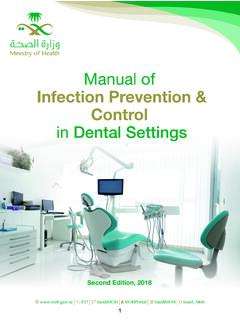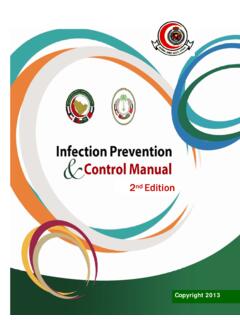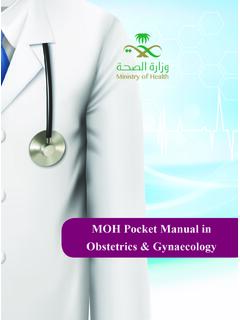Transcription of MOH Pocket Manual in General Surgery
1 MOH Pocket Manual in General Surgery MOH Pocket Manual in General Surgery Table of Contents Chapter 1: Upper GIT 5. Perforated peptic ulcer 6. Gastric outlet obstruction 10. Upper GI bleeding 14. Chapter 2: Lower GIT 17. Bowel obstruction 18. Appendicitis 23. Anorectal disease Anal fissure 28. Fistual in ano 31. Hemorroid 34. Pilonidal sinus 39. Lower GI bleeding 41. Chapter 3: Hepatobiliary 45. Gallstones 46. Acute Cholecystitis 48. Choledocholithiasis 52. Pancreatitis 55. Chapter 4: Hernia 61. Chapter 5: Skin and soft tissue 69. Cellulitis and Erysipelas 70. Diabetic septic foot 73. Surgical site infection (SSI) 76. Chapter 6: Trauma 81. Table of Contents 3.
2 Chapter 1. UPPER GIT. MOH Pocket Manual in General Surgery Perforated Peptic Ulcer Overview o Epidemiology The 15% death rate correlates with increased age, female sex, and gastric perforations Severity of illness and occurrence of death are directly related to the interval between perforation and surgical closure Clinical Presentation o Symptoms Sudden, severe upper abdominal pain which typically occurs several hours after the last meal There may be a history of previous dyspepsia, previous or current Treatment and management for peptic ulcer or ingestion of NSAID. Rarely is heralded by nausea or vomiting Shoulder pain. Back pain is uncommon o Signs The patient appears severely distressed, lying quietly with the knees drawn up and breathing shallowly to minimize abdominal motion Fever and hypotension (late sign).
3 The Epigastric tenderness may not be as marked as expected because the board-like rigidity Tympanitic percussion over the liver and ileus 6 UPPER GIT. MOH Pocket Manual in General Surgery Differential Diagnosis o Hepatobiliary: hepatitis, cholecystitis, pancreatitis, cholangitis o Intestine: appendicitis, colitis, bowel perforation, ischemia o Extraabdominal: inferior myocardial infarction, basal pneumonia Work Up o Laboratory CBC: leukocytosis Serum amylase mildly elevated ABG: metabolic acidosis o Imaging Erect chest x-ray: air under diaphragm in 85%. CT scan abdomen with IV and PO contrast in doubtful cases Treatment and management (See Flowchart 1).
4 O Medical therapy (See Table 1). Non- operative management is appropriate only if there is clear evidence that the leak has sealed (by contrast study) in the absence of peritonitis IV antibiotic and proton pump inhibitor UPPER GIT 7. MOH Pocket Manual in General Surgery o Surgical therapy Laparotomy and omental patch for perforated duodenal ulcer and prepyloric gastric ulcer Resection for gastric ulcer (most likely cancerous). Red Flag o Acute onset or chronic symptoms o Shock and peritonitis o Air under diaphragm but minimal symptoms and signs (sealed perforation). Reference 1-Hassan Bukhari. Puzzles in General Surgery . 1st ed. Minneapolis: Tow Harbors Press 2013.
5 8 UPPER GIT. MOH Pocket Manual in General Surgery UPPER GIT 9. MOH Pocket Manual in General Surgery Gastric Outlet Obstruction Overview o Epidemiology Occurs in 2% of patients with ulcer disease causing obstruction of pylorus or duodenum by scarring and inflammation Cancer must be ruled out because most patients who present with symptoms of gastric outlet obstruction will have a pancreatic, gastric, or duodenal malignancy Clinical Presentation o Symptoms Nausea, nonbilious vomiting contains undigested food particles, early satiety, bloating, anorexia, epigastric pain and weight loss o Signs Chronic dehydration and malnutrition Tympanitic mass (dilated stomach in the epigastric area and/.)
6 Or left upper quadrant Succussion splash in the epigastrium Differential Diagnosis o Hepatobiliary: Pancreatitis, pancreatic cancer o Stomach: volvulus, obstructed hiatus hernia, foreign body 10 UPPER GIT. MOH Pocket Manual in General Surgery Work Up o Laboratory: CBC, electrolyte panel, Liver function tests o Imaging Plain abdominal radiograph Contrast upper GI studies (Gastrografin or barium). CT scans with oral contrast o Upper endoscopy with biopsy Treatment and management (See flowchart 2). o Medical therapy (See Table 1). Resuscitation and correction of electrolyte imbalance IV proton pump inhibitor NPO and NG tube eradication o Surgical therapy Antrectomy vs.
7 Vagotomy vs. dilatation / stenting Red Flags o Weight loss and anorexia o Unexplained anemia o Palpable mass References UPPER GIT 11. MOH Pocket Manual in General Surgery 1-Andres E Castellanos, MD; Chief Editor: John Geibel, MD, DSc, MA : Gastric Outlet Obstruction . eMedicine of Medscape 2- Daniel T. Dempsey : Chapter 26. Stomach . Schwartz's Principles of Surgery , 9e , 2010. 3-Gerard M. Doherty, MD, Lawrence W. Way, MD. CURRENT Work Up and Treatment and management : Surgery , 13e , 2010. 4-Maxine A. Papadakis, MD , Stephen J. McPhee, MD. Quick Medical Work Up and Treatment and management , 2013. 12 UPPER GIT. MOH Pocket Manual in General Surgery Flowchart 2: Peptic Ulcer and Gastric Outlet Obstruction Suspecting peptic ulcer disease based on history and examination Initial mamagement CBC, chemistry, coagulation liver function, amylase Erect chest x-ray Red Flag Features Epigastric pain, severe nanusea and non-bilious vomiting, weight loss, epigastric No Yes fullness Simple, Urgent CT.
8 Uncomplicated abdomen with peptic ulcer PO + IV contrast Proton pump inhibitor No Gastric outlet Lifestyle modi cation Gastroenterology referral obstruction Yes Resuscitation Correction of electrolyte Rule out malignancy NPO, NGT. Surgery Proton pump inhibitor IV. Anrectomy vs vagotomy Failed Pantoprazole Dilatation/stenting is Endoscopy to rule out an option malignant cause eradication eradication UPPER GIT 13. MOH Pocket Manual in General Surgery Upper GI Bleeding Overview o Definition: bleeding proximal to the ligament of Treitz, which accounts for 75% of GI bleeding o Etiology Above the GE junction: epistaxis, esophageal varices (10-30%), esophagitis, esophageal cancer, Mallory-Weiss tear (10%).
9 Stomach: gastric ulcer (20%), gastritis ( from alcohol or post- Surgery ) (20%), gastric cancer Duodenum: ulcer in cap/bulb (25%), aortoenteric fistula post aortic graft Coagulopathy: drugs, renal disease, liver disease Vascular malformation: Dieulafoy's lesion, AVM. Clinical Presentation o In order of decreasing severity of the bleed: hematochezia followed by hematemesis, coffee ground emesis, melena and then occult blood in stool Treatment and management (See flowchart 3). o Initial management (See Table 2). Resuscitation and monitoring (2 large bore IV lines, fluid, urinary catheter). Send blood for CBC, cross and type, coagulation profile, electrolytes, liver and kidney functions Keep NPO and insert NGT.
10 14 UPPER GIT. MOH Pocket Manual in General Surgery IV Proton pump inhibitors. It decreases risk of rebleeding if endoscopic predictors of rebleeding are seen It is given to stabilize clot, not to accelerate ulcer healing If it is given before endoscopy, it decreases the need for endoscopic intervention In case of esophageal varices: IV octreotide (50 mcg loading dose followed by constant infusion of 50 mcg/hr and IV. antibiotic (ciprofloxacin). Consider IV erythromycin (or metoclopramide) to accelerate gastric emptying prior to gastroscopy to improve visualization o Localization of the bleeder: esophagogastroduodenoscopy (EGD). o Definitive management EGD: establish bleeding site+ treat lesion Bleeding peptic ulcer: injection of epinephrine around bleeding point, thermal hemostasis (bipolar electrocoagulation or heater probe) and endoclips Variceal bleeding: banding or glue injection, the medical therapy +/ - TIPS.)









